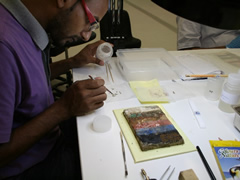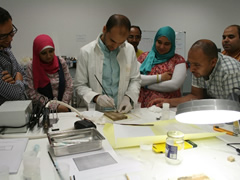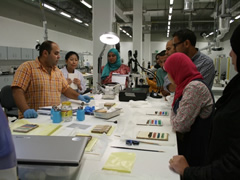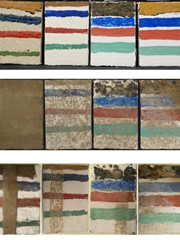- Home
- Technical Cooperation Projects
- Index of Countries
- Middle East
- Egypt
- The Project for the Conservation Center in the Grand Egyptian Museum
- Project News
- Training course in "painted objects" (4th) was held
Project News
2015-08-13
Training course in "painted objects" (4th) was held
During the period of the 4th of August and the 13th of August, 2015, the 4th training course on conservation of artefacts containing colour was held in GEM-CC. 11 of GEM-CC staff's scientists and conservators attended the course which was instructed by Dr. Yoko Taniguchi (Assistant Professor specializing in conservation science, Graduate School of Humanities and Social Sciences, University of Tsukuba,), Ms. Akiko Nishisaka (Institute of Egyptology, Waseda University, and Adjunct Researcher) and Ms. Kumi Masuda (Masuda Painting conservator in an independent conservation studio).
One of the main properties of the ancient Egyptian artefacts is the usage of paint layer(s) in whether it was made of papyrus, textile, wooden and stone or in mural paintings and portraits. Therefore, a training course aiming to help the trainees acquire the common basic knowledge about material properties and characteristics of paint layer(s) and on methodologies of conservation for materials with paint layer(s) was much needed. In 2012, The JICA GEM-CC started the "painted object" training courses which consisted of 4 stages with this stage being the fourth and the final stage.
The painted objects training courses as a whole focused on learning the wide variety of techniques and methods of conservation treatments in painted objects as well as deepening the cross-sectional cooperation system including conservation science and analysis through practical training. The most important feature of these courses was that the trainees were provided with the chance to learn the principle of "minimum intervention" in conservation suitable to the case of the artefact at hand and finding new techniques to use in their different specialities to restore the artefacts without resorting to the old invasive techniques of restoration that was held routinely previously. Therefore this course is thought to be a step towards a new technique in restoration of ancient Egypt artefacts.
In the first stage of the training (2011), trainees learnt about various kinds of painting techniques and materials which have been used in Egypt, and they made different kinds of replicas to understand each characteristics and physical properties before they begin real conservation work.
In the second stage (2013), trainees applied accelerated aging on replicas, documented the process regularly, and prepared them as materials for conservation. They learnt methods of how to identify and examine deterioration mechanism analytically. They also created forms to be used at the GEM-CC to document the examination of the state of the artefacts at hand as well as form for the observation and analysis process.
In the third stage (2014),trainees learnt about cleaning, consolidation and filling, through practicing intervention of real conservation processon two artificially deteriorated replicas resembling the ancient Egyptian mud mural paintings, and six real Japanese artefactswith painted layers removed or discoloured
In this stage being the fourth and final stage of the training, the main focus was on practical training. The trainees practiced the process of cleaning, consolidation and filling under the supervision of the Japanese professors and worked on their knowledge about the documentation and the basic ethics and application techniques of conservation.
During this stage, the main focus was on the practical training which helped strengthen the team work between the conservators and the scientists and improved their analytical skills and documentation skills.
In this stage, the trainees showed an immense improvement and innovation in regards to their conservation techniques and their general way of thinking when it comes to choosing the appropriate conservation material and technique showing that this course was a great step towards developing better techniques for Egyptian artefacts conservation.
 Adhering the separated pieces
Adhering the separated pieces
 Gel solvent cleaning
Gel solvent cleaning
 Discussion about the conservation process of each group
Discussion about the conservation process of each group
 From top to bottom, the replica before the deterioration as of February 2013, the replica after the deterioration as of February 2014, the replica after the treatment as of August 2015 (From left to right, bees wax, linseed oil,
tragacanth gum, and Animal glue as binding media)
From top to bottom, the replica before the deterioration as of February 2013, the replica after the deterioration as of February 2014, the replica after the treatment as of August 2015 (From left to right, bees wax, linseed oil,
tragacanth gum, and Animal glue as binding media)
- About JICA
- News & Features
- Countries & Regions
- Our Work
- Thematic Issues
- Types of Assistance
- Partnerships with Other Development Partners
- Climate Change / Environmental and Social Considerations
- Evaluations
- Compliance and Anti-corruption
- Science and Technology Cooperation on Global Issues
- Research
- JICA Development Studies Program / JICA Chair
- Support for the Acceptance of Foreign HRs / Multicultural and Inclusive Community
- Publications
- Investor Relations
